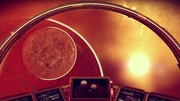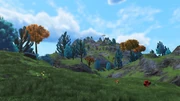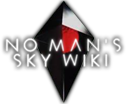| The subject of this article is from the Visions update.
The information from this article is up-to-date as of 13 August, 2019. |
The information from this article is up-to-date as of 13 August, 2019.

A planet and its moon seen from space (Foundation)
A planet is an astronomical body that moves around a star.
Summary
A planet is an astronomical body moving in an elliptical orbit around a star. Players will start on a random planet in a star system near the edge of the Euclid galaxy. When players land on another planet, the planet's basic information, e.g. weather conditions, flora & fauna frequency, will be revealed to the player.
However, players may also scan a planet before landing, receiving approximate information regarding its biome through an adjective, e.g. Acidic/Tropical, and a specific listing of some valuable resources available on the planet.
Based on the associated biome, some planets will contain special features that other planets will not possess. For example, the Exotic biome on a planet in the Zuunurt system. (MOGO:0EFD:007C:07AF:019F) displays large hexagons on its surface.
Since NEXT the terrain and planet type is also visible from space and a mostly accurate projection of what will be encountered post landing.
General information
The universe of No Man's Sky is populated by 18 quintillion procedurally-generated planets of many sizes, colors, and biomes. Each planet orbits a star and rotates around its own axis, creating a cycle of day and night. The duration of a day, or Sol in No Man's Sky universe is about 15 minutes real-time. Although no Binary Systems have been confirmed, Sean Murray said that binary systems are probably present in the game.
Some planets are harmless, without worry or danger, but some can be very dangerous to the extent that the planet cannot be explored because of the danger. Initial names of the planets are procedurally generated and can be hard to pronounce, which is not unusual in a sci-fi game. The first player to discover the planet gets one chance to choose to rename it before uploading the information. Planet naming will go through a standard profanity filter.
Planets should be added to the Planets category page as they are discovered and logged.
Planets (except for the Dead type) will have Points of Interest (i.e. Waypoints) for the player to discover.
Influences

Planet surface (NEXT)
The following information is displayed when landing on a planet, and in the discovery screen. They influence what you can find on a planet, and what its conditions will be.
- Biome influences the flora, fauna and the general environmental hazard.
- Weather influences the intensity of the environmental hazard and the presence of Exotic elements.
- Sentinel behaviour influences how strict they are about the player breaking their rules. If red it means they will even attack on sight, which indicates the presence of natural trade commodities.
- Flora influences the amount, and density of flora present on the planet. This rarity can be high, middle, low or none.
- Fauna influences the amount, and density of fauna present on the planet. This rarity can be high, middle, low or none.
The rarity is set by the following terms for both the flora and the fauna. The sequence is taken from the game file.
Rarity - High
- Abundant
- High
- Ample
- Frequent
- Full
- Generous
- Bountiful
- Copious
- Rich
- Abundant
Rarity - Middle
- Average
- Regular
- Common
- Typical
- Ordinary
- Occasional
- Numerous
- Moderate
- Fair
- Medium
Rarity - Low
- Low
- Scarce
- Infrequent
- Rare
- Limited
- Sporadic
- Intermittent
- Uncommon
- Few
- Sparse
Rarity - None
- None
- Deficient
- Undetected
- Lacking
- Absent
- Nonexistent
- Empty
- Not Present
- Devoid
- Barren
Additional Information
The type of star a planet orbits is important for some biomes to appear. The main example are exotic planets in atypical stars.
A moon (and sometimes more than one) can be found in orbit around some large planets. A planet can only have two moons, which limits a system's maximum moons to 4 as only 6 stellar objects are generated.
Some planets have rings surrounding them, which are made up of asteroids and crystals. However mining in a ring is difficult because as soon as one enters a ring it becomes very hard to see due to the fine particles. Sometimes a planet with a ring may also have a moon, this may cause the ring to clip inside said moon.
All planets bearing water appear "oceanic" from space, meaning several parts of their surface show ocean terrain types and a large percentage of their surface will have pockets of water inside. If one digs down in a valley or plain a layer of underground water can be found. All moons however are pangean in nature. The prevalence of water does not prefer any biome type, but excludes dead and seemingly exotic worlds.
Discovered planets
For a list of discovered planets, see the Planets category page. For a list of pre-release planets, see the Pre-release planets category page.
(When creating a new page for a planet, please use the Planet option from the pre-built templates.)
Name generation
The names are procedurally generated using one of the following styles and in certain cases the Adornment term is used.
The sequence is taken from the game file.
Style
- ProcNorm
- ProcNorm + Adornment
- ProcNorm + Numeral
- ProcNorm + ShortCode
- ProcLong + ProcShort
- ProcShort + LongCode
- "New" + ProcNorm
The list is based on the planets documented by their original names on the wiki:
- ProcShort: It uses 3-5 letters.
- ProcNorm: It uses 4-9 letters.
- ProcLong : It uses 6-10 letters.
- Numeral: It uses roman numerals, for example V or XVII.
- ShortCode: It uses 3 characters and the format is LNN where L is an upper case letter and N is a numeral, for example S10.
- LongCode: It uses 5 characters and the format is NN/LN where L is an upper case letter and N is a numeral, for example 72/T3.
Adornment
- Prime
- Major
- Minor
- Alpha
- Beta
- Gamma
- Delta
- Omega
- Sigma
- Tau
Additional information
- The rarity terms for flora and fauna are extracted from the NMS_LOC1_ENGLISH.MBIN (1.77) game file, while the name generation is extracted from the NMS_UPDATE3_ENGLISH.MBIN (1.77) game file.
- There is a 42 character limit when renaming a planet or a moon.
Speculation
It is physically impossible for water to be liquid below -73,15 °C; depending on the pressure it is either solid or gas. Some planets have oceans at this temperature. So, we can assume that not all planets' liquids are made up of water. It is easiest to do this if you forget that the suit voice always refers to liquids as water.
Gallery
Dead planet - part of update 1.30 - Bubbles all over the surface.
(Atlas Rises)















